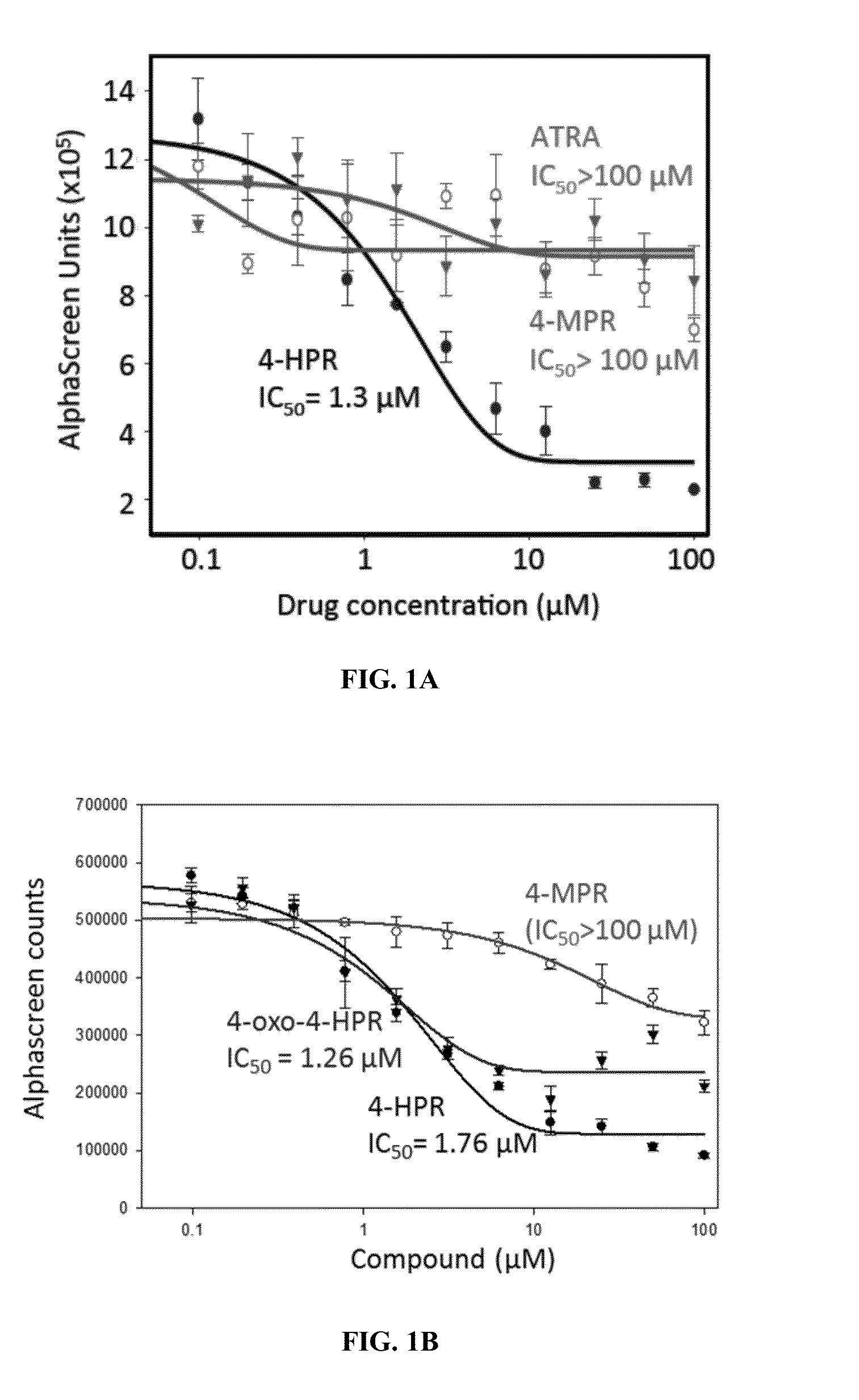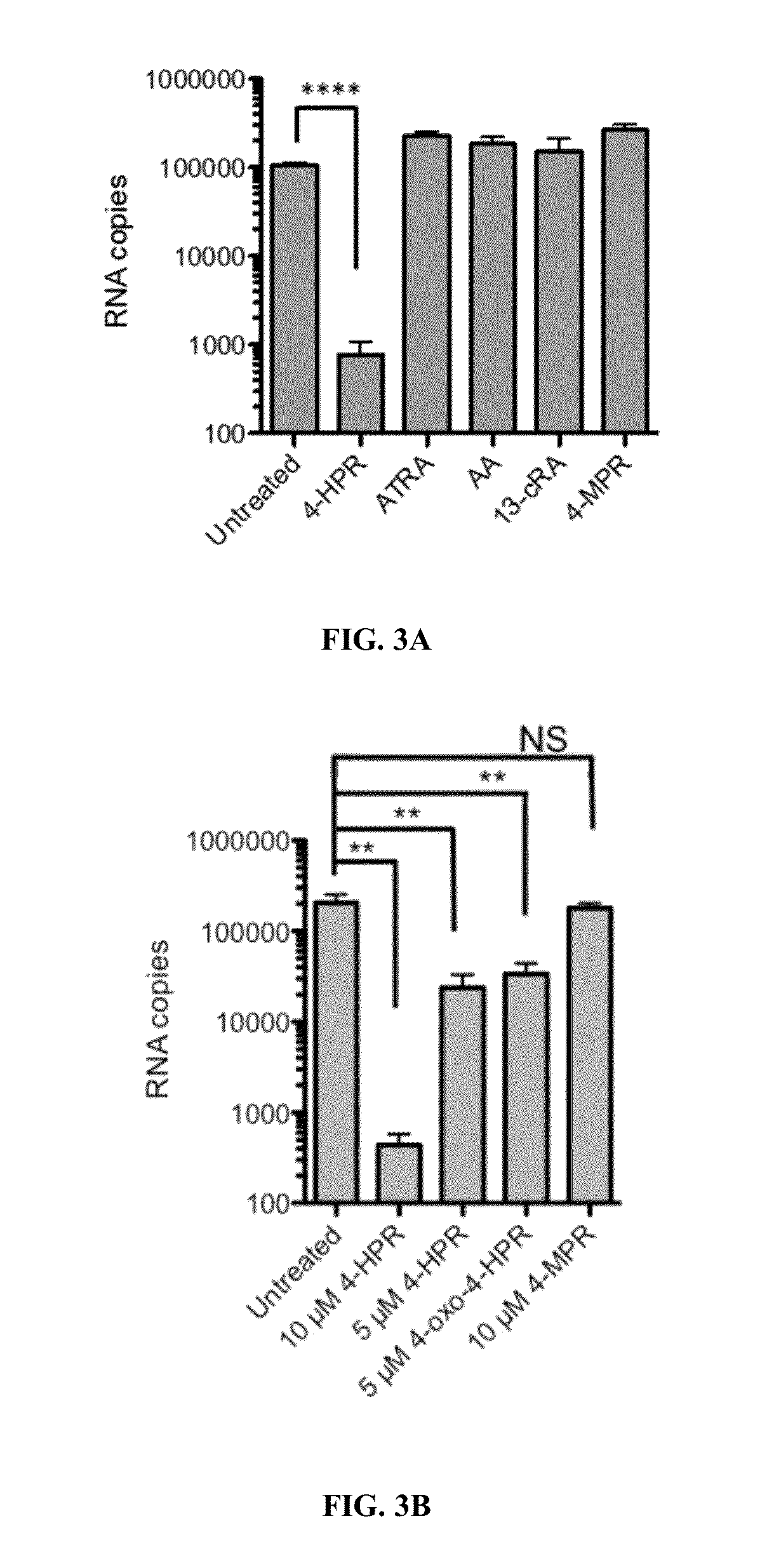Method of viral inhibition
- Summary
- Abstract
- Description
- Claims
- Application Information
AI Technical Summary
Benefits of technology
Problems solved by technology
Method used
Image
Examples
example 1
Effect of Retinoic Acid Analogues on NS5-IMPα / β1 Association
[0094]To investigate the structure / activity relationship for 4-HPR and 4-oxo-4-HPR, all-trans retinoic acid (ATRA; the parent compound of 4-HPR) and N-(4-methoxyphenyl) retinamide (4-MPR; a closely related analogue of 4-HPR) were compared in their ability to inhibit association of NS5 with IMPα / β1:
[0095]ALPHASCREEN®, a luminescent bead-based assay that measures direct protein-protein interactions, was used to examine the binding of 3 nM His6-NS5 to 10 nM IMPα / β1 (IMPα / β1 heterodimer containing biotinylated IMPβ1) in the presence of increasing concentrations of 4-HPR, 4-MPR or ATRA (FIG. 1A), or 4-oxo-4-HPR, 4-HPR or 4-MPR (FIG. 1B). Data are the mean+standard deviation (SD) of triplicate wells from a single typical experiment.
[0096]4-HPR and 4-oxo-4-HPR were the only retinoic acid analogues able to block association of DENV-2 NS5 with IMPα / β1 (FIG. 1A and FIG. 1B). In contrast to 4-HPR and 4-oxo-4-HPR, neither ATRA nor 4-MP...
example 2
Specific Inhibition of DENV-2 NS5 Association with IMPα
[0097]To investigate the specificity of 4-HPR inhibition of NS5-importin association, the binding of 30 nM His6-NS5 to 10 nM IMPα / β1, (IMPα / β1 heterodimer containing biotinylated IMPβ1), 3 nM IMPαΔIBB (biotinylated IMPα with the IMPβ-binding domain removed), or 3 nM biotinylated IMPβ1, in the presence of increasing concentrations of 4-HPR, was investigated. 4-HPR was found to interfere with association of NS5 and IMPα / β1, as well as NS5 and IMPαΔIBB (a truncated form of IMPα which lacks the auto-inhibitory IMPβ-binding domain), with 50% inhibition of binding occurring at similar concentrations (average IC50 of 1.2 and 1.6 μM, respectively, from 3 independent experiments; representative assay shown), while NS5 binding to IMPβ1 alone was largely unaffected by the presence of 4-HPR.
[0098]These further investigations determined that 4-HPR prevents NS5 from binding to the NLS binding site on IMPα in vitro, by targeting either or both...
example 3
4-HPR Antiviral Specificity
[0099]To test the specificity of 4-HPR and 4-oxo-4-HPR for anti-DENV activity Vero cells were infected with DENV-2 with a multiplicity of infection (MOI) of 1, in the presence of drug diluent (untreated) or the indicated compounds (10 μM in FIG. 3A, or 10 μM or 50 μM as indicated in FIG. 3B) for 2 h, followed by removal of the virus / drug inoculums, and addition of fresh 2% FCS maintenance medium. At 24 h post infection (p.i.) the culture medium was collected and the viral RNA extracted using QIAamp viral RNA mini kit (Qiagen). Absolute RNA copies present in each sample were determined by Taqman One Step RT-PCR (Applied Biosystems), as an estimate of virus titre by extrapolation from a standard curve generated from in vitro transcribed DENV RNA. Data shown are the mean+standard error of the mean (SEM) for 3 (FIG. 3A) or 2 (FIG. 3B) independent experiments. Statistical analysis (Student's t test) was performed using GraphPad Prism software. 4-HPR was found t...
PUM
 Login to View More
Login to View More Abstract
Description
Claims
Application Information
 Login to View More
Login to View More - R&D
- Intellectual Property
- Life Sciences
- Materials
- Tech Scout
- Unparalleled Data Quality
- Higher Quality Content
- 60% Fewer Hallucinations
Browse by: Latest US Patents, China's latest patents, Technical Efficacy Thesaurus, Application Domain, Technology Topic, Popular Technical Reports.
© 2025 PatSnap. All rights reserved.Legal|Privacy policy|Modern Slavery Act Transparency Statement|Sitemap|About US| Contact US: help@patsnap.com



